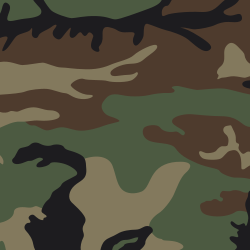| U.S. Woodland | |
|---|---|
 Digitized swatch of the U.S. Woodland pattern | |
| Type | Military camouflage pattern |
| Place of origin | United States |
| Service history | |
| In service |
|
| Used by | See Users (for other non-U.S. users) |
| Wars | Invasion of Grenada United States invasion of Panama Lebanese Civil War Somali Civil War Colombian conflict Yugoslav Wars Operation Uphold Democracy War in Afghanistan Iraq War 2006 Lebanon War Mexican drug war 2008 Cambodian-Thai stand-off Russo-Georgian War Libyan civil war (2011) Syrian Civil War Russo-Ukrainian War 2025 Cambodia–Thailand border conflict |
| Production history | |
| Produced | 1980–present |
U.S. Woodland was the former standard issue camouflage pattern of the United States Armed Forces from 1981 to 2005 in the cut of the Battle Dress Uniform and a dozen other pieces of clothing that were issued, until its replacement in the early 2010s. [1] It is a four color, high contrast disruptive pattern with irregular markings in green, brown, sand and black. It is also known unofficially by its colloquial moniker of "M81" after the year of its adoption, [2] however this term was never officially used by the U.S. military.
Contents
- Development and history
- Usage
- U.S. Army
- U.S. Navy
- U.S. Marines
- U.S. Air Force
- State defense forces
- Law enforcement
- Users
- Former users
- See also
- References
- Bibliography
Although BDUs have been long phased out of frontline use in the U.S. Armed Forces, U.S. Woodland is still used on some limited level since MOPP suits, vests, and other equipment were printed in it and never fully replaced. Some modernized uniforms such as modified BDUs and FROG gear were used by special forces such as the USMC Forces Special Operations Command and United States Navy SEALs.






